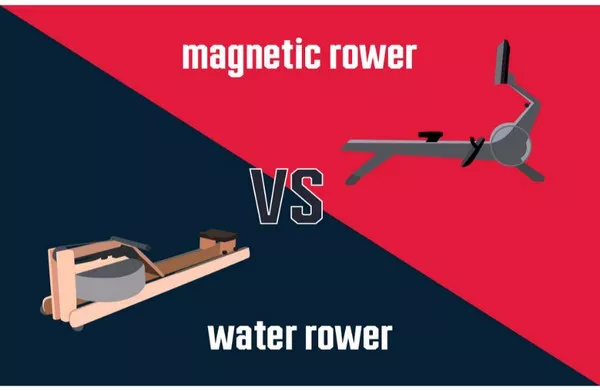In the realm of home fitness equipment, rowing machines stand out as efficient, full-body workout tools. Among the various types available, magnetic and water rowing machines are two popular options, each with its own set of features and advantages. Deciding between them requires a closer examination of their mechanisms, key features, pros and cons, and ultimately, what suits individual needs and preferences best.
Understanding Magnetic and Water Rowing Machines:
1. Mechanism:
The fundamental difference between magnetic and water rowing machines lies in their resistance mechanisms. Magnetic rowers utilize magnets to generate resistance, whereas water rowers rely on water displacement. In magnetic rowing machines, the resistance level is adjusted by altering the distance between the magnets or changing the strength of the magnetic field. In contrast, water rowers create resistance by pulling against the water in the tank, with the resistance increasing as the rower exerts more force.
2. Resistance Levels:
Both types of rowing machines offer adjustable resistance, but the method differs. Magnetic rowers typically have a broader range of resistance levels that can be easily adjusted with a dial or digital interface. Water rowers, on the other hand, provide a dynamic resistance that mimics the feel of rowing on actual water, with the resistance increasing or decreasing based on the user’s stroke intensity.
3. Feel of the Rowing Stroke:
The rowing experience varies significantly between magnetic and water rowing machines. Magnetic rowers are known for their smooth and consistent resistance, offering a predictable stroke every time. However, some users find them lacking the realistic feel of water resistance. Water rowers provide a more authentic rowing experience, with resistance that closely mimics the sensation of rowing on water. This dynamic resistance makes the stroke feel more fluid and natural.
Comparing Key Features:
1. Noise Level:
One of the notable differences between magnetic and water rowers is the noise level. Magnetic rowing machines operate quietly, making them ideal for home use, especially in shared living spaces. In contrast, water rowers produce a soothing sound as the water swirls in the tank, which some users find pleasant but may be disruptive in quieter environments.
2. Maintenance:
Maintenance requirements vary between magnetic and water rowing machines. Magnetic rowers typically require minimal maintenance, with no water to change or tanks to clean. However, water rowers need occasional maintenance to ensure water quality and prevent algae growth. This may involve adding water purification tablets or periodically replacing the water in the tank.
3. Footprint and Storage:
In terms of size and storage, magnetic rowing machines tend to be more compact and easier to store, with many models featuring folding capabilities for space-saving convenience. Water rowers, while generally larger and bulkier, can still be stored upright or on their side to conserve space when not in use.
4. Technology and Data:
Both magnetic and water rowing machines come equipped with performance monitors to track workout metrics such as time, distance, strokes per minute, and calories burned. Many modern rowers also offer additional features like built-in workout programs, Bluetooth connectivity for syncing with fitness apps, and compatibility with heart rate monitors.
Pros and Cons:
1. Magnetic Rowers:
Pros: Quiet operation, low maintenance, compact size.
Cons: Potential lack of realistic feel, limited resistance range compared to high-end water rowers.
Water Rowers:
Pros: Realistic rowing experience, smooth resistance, aesthetically pleasing design.
Cons: Noise, maintenance requirements, bulkiness.
Which is Better?
Choosing between magnetic and water rowing machines ultimately depends on individual preferences and priorities. Consider factors such as budget, available space, desired noise level, and the type of rowing experience you prefer.
For apartment dwellers or those with limited space who prioritize a quiet and compact option, magnetic rowing machines may be the better choice. On the other hand, if you value a realistic rowing experience and don’t mind the extra noise or maintenance, a water rowing machine could be more suitable.
Additional Considerations:
1. Price Range:
The price range for magnetic and water rowing machines varies depending on factors such as brand, features, and build quality. Magnetic rowers typically range from a few hundred to over a thousand dollars, while water rowers tend to be on the higher end of the spectrum, ranging from around $700 to $2500 or more.
2. Popular Brands and Models:
Some well-regarded brands for magnetic rowers include Concept2, NordicTrack, and Stamina. For water rowers, WaterRower and First Degree Fitness are among the most recognized brands, offering high-quality machines with innovative designs.
Conclusion
In conclusion, both magnetic and water rowing machines offer effective workouts with unique features and advantages. By considering your preferences, budget, and space constraints, you can make an informed choice that aligns with your fitness goals and lifestyle. Whether you opt for the quiet efficiency of a magnetic rower or the immersive experience of a water rower, investing in a quality rowing machine can enhance your fitness journey for years to come.

